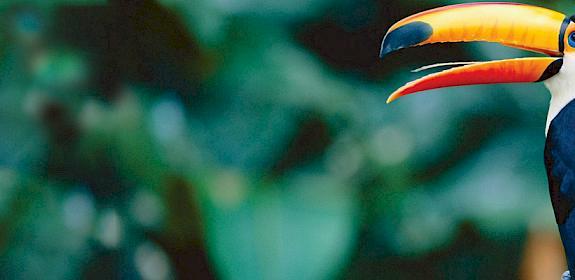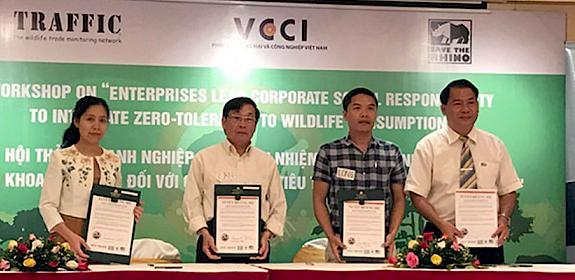The coronavirus pandemic and wildlife trade - TRAFFIC’s perspective
Background
A new coronavirus, designated SARS-CoV-2, is causing a health pandemic with people infected by a new disease known as Covid-19, which can have fatal consequences.
As of 24th March 2020, 16,365 human fatalities had been reported across more than 150 countries with over 378,000 confirmed cases of Covid-19.
The origin of the virus is still unclear but appears to have a strong likelihood of connection to the trade of wild animals although potentially any animal trade carries with it risk of zoonotic disease transmission.
The global response and immediate concern is quite rightly focused on the public health impacts, in an effort to limit the number of human fatalities.
Alongside the primary efforts to address the impacts on human health, policy changes are also underway regarding the regulation of trade in wildlife. TRAFFIC believes there are vital lessons for authorities to take on board regarding the management of wildlife trade, including to reduce the likelihood of further zoonotic threats.
Origins
The precise source of the SARS-CoV-2 virus is unknown at this stage.
In terms of geographic origin, the epicentre of the outbreak is widely considered to be a seafood market in Wuhan known to have been selling wild animals.
In terms of virus origin, the likely natural animal “reservoirs" for coronaviruses are bats, where they circulate with little impact on those animals themselves. Coronaviruses are known to be widespread in bat populations within China. As recently as March 2019, a team of virologists in Wuhan published a paper highlighting the occurrence of coronaviruses in bats and commented that it was “highly likely that future SARS- or MERS-like coronavirus outbreaks will originate from bats, and there is an increased probability that this will occur in China”.
Earlier disease outbreaks, notably the SARS outbreak of 2002/2003 and the MERS outbreak of 2013 are both considered to have originated in bat coronaviruses which made the species jump to humans via civets and camels respectively.
The World Health Organization in the early stages of the pandemic made a statement that the virus was likely to have originated in bats and might have made the jump to people via a currently unknown animal group. The presumed bat origin of SARS-CoV-2 has already been highlighted.
However, the intermediate animal group in the transmission chain is still open to question.
Currently the prime focus is on pangolins, largely owing to a paper published in October 2019 on the occurrence of coronavirus infection in Malayan Pangolins and a statement by researchers at the South China Agricultural University concerning their studies claiming to show the origins in pangolins. However, their original claims have not stood up to scrutiny, although a Current Biology paper describes the link as “probable”.
Pangolins are therefore among the leading candidates for the “intermediate” species in SARS-Cov-2’s evolution.
There are no clues as to where the transfer from bats to the intermediate host [maybe pangolins] may have taken place, but the transfer from the intermediate host to people is believed to have taken place in a so-called “wet market” where live animals are sold. These markets are not well-regulated and often the conditions under which trade is carried out are unsanitary, with people in close proximity to animals—the circumstances under which viruses are enabled to make the species jump into people.
Taking precautionary action
TRAFFIC fully supports the tough emergency measures introduced to regulate wildlife trade and consumption in China in February 2020, urges swift adoption of similar restrictions under discussion in Viet Nam and encourages other countries to consider the merits of urgent precautionary actions to reduce zoonotic disease risks.
Such moves to address illegal and unregulated trade in wildlife are to be applauded for the raising of deterrents to illicit behaviour and should be pursued with additional zeal and precision at this time to send a strong message that such trade—whether in physical premises or online—is part of an infrastructure that can threaten human health as well as the conservation of biodiversity.
A number of organisations and public voices are calling for strong permanent restrictions on wild animal trade. Any new measures will need to be clear about what species and products pose the greatest risks and what regulatory measures might have greatest impact. Design of such measures should take due consideration of the risk that outlawed activities might continue underground if law enforcement efforts are inadequate.
TRAFFIC believes countries who have not taken emergency restrictions on wild animal trade given the present circumstances should consider the merits of doing so, while any future relaxation of these restrictions should only be contemplated once a full and thorough risk assessment has been carried out. Attention to zoonotic disease risks may well require a complete overhaul of wildlife trade policy and law. Strengthened measures are required to ensure the legality, sustainability and traceability of the specimens and products concerned, and adequate resources to ensure full monitoring are in place to mitigate against the risk of disease emergence.
Essential considerations include:
- Strengthened legislation and regulations controlling the import and export, sale and consumption of meat and other products and derivatives for human consumption from wild animals
- Strengthened legislation and regulations governing veterinary and animal health rules governing the production, processing, distribution and introduction of products of animal origin for human consumption
- Development and implementation of management tools to enhance traceability, certification and monitoring of the trade in these products
Expert agencies from across a variety of relevant disciplines—including virologists, epidemiologists, trade experts, law enforcement agencies, agricultural experts—should be consulted and their input considered before any decision is taken at the national level.
Given the scale of global concern, the input of relevant international agencies to developing new wildlife trade policies should also be sought, potentially including the CBD, CITES, FAO and WHO.
In the medium to long-term, after a full evaluation of the risks and before any trade could be countenanced, governments would need to take measures to prevent future outbreaks of disease originating from trade in wild animals.
Timeline
Late December 2019: a new coronavirus is reported in China, with dozens of human cases reported, apparently centred on a seafood market in Wuhan, which it later emerges has been selling wildlife. At the time, there was no evidence the virus was readily infectious to humans.
On 11th January, China reported its first human fatality linked to the illness caused by the new virus.
Later in January, the city of Wuhan was put into lock down while the first cases of Covid-19 appeared in countries outside of China.
On 26th January, Chinese authorities announced a nationwide temporary ban on wildlife trade in markets, supermarkets, restaurants, and e-commerce platforms.
By the end of the month, the World Health Organization had declared a global health emergency.
Despite countries restricting travel to and from infected areas, the virus has spread worldwide.
Over the coming weeks, Iran, South Korea and Italy in particular reported serious outbreaks of Covid-19, with cases and fatalities in the latter rapidly exceeding those in mainland China.
On 24th February, authorities in China announced tough new measures—including an unprecedented ban on the consumption of wild animals as food—aimed at reducing the risks to public health from infectious viruses generated in association with poorly managed trade in wild animal species.
As of late March 2020, European countries, in particular Italy, Spain, Germany, France, Netherlands, Switzerland and the UK plus the US have become the new epicentre for the virus and the associated disease.




